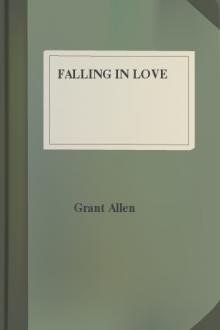Falling in Love by Grant Allen (different e readers .txt) 📕

- Author: Grant Allen
- Performer: -
Book online «Falling in Love by Grant Allen (different e readers .txt) 📕». Author Grant Allen
First soil, then plant and animal life, are thus in the last resort wholly dependent for their existence on the amount of rainfall. But in deserts, where rain seldom or never falls (except by accident) the first term in this series is altogether wanting. There can be no rivers, brooks or streams to wash down beds of alluvial deposit from the mountains to the valleys. Denudation (the term, though rather awful, is not an improper one) must therefore take a different turn. Practically speaking, there is no water action; the work is all done by sun and wind. Under these circumstances, the rocks crumble away very slowly by mere exposure into small fragments, which the wind knocks off and blows about the surface, forming sand or dust of them in all convenient hollows. The frequent currents, produced by the heated air that lies upon the basking layer of sand, continually keep the surface agitated, and so blow about the sand and grind one piece against the other till it becomes ever finer and finer. Thus for the most part the hollows or valleys of deserts are filled by plains of bare sand, while their higher portions consist rather of barren, rocky mountains or table-land.
The effect upon whatever animal or vegetable life can manage here and there to survive under such circumstances is very peculiar. Deserts are the most exacting of all known environments, and they compel their inhabitants with profound imperiousness to knuckle under to their prejudices and preconceptions in ten thousand particulars.
To begin with, all the smaller denizens of the desert—whether butterflies, beetles, birds, or lizards—must be quite uniformly isabelline or sand-coloured. This universal determination of the desert-haunting creatures to fall in with the fashion and to harmonise with their surroundings adds considerably to the painfully monotonous effect of desert scenery. A green plant, a blue butterfly, a red and yellow bird, a black or bronze-coloured beetle or lizard would improve the artistic aspect of the desert not a little. But no; the animals will hear nothing of such gaudy hues; with Quaker uniformity they will clothe themselves in dove-colour; they will all wear a sandy pepper-and-salt with as great unanimity as the ladies of the Court (on receipt of orders) wear Court mourning for the late lamented King of the Tongataboo Islands.
In reality, this universal sombre tint of desert animals is a beautiful example of the imperious working of our modern Deus ex machinâ, natural selection. The more uniform in hue is the environment of any particular region, the more uniform in hue must be all its inhabitants. In the arctic snows, for example, we find this principle pushed to its furthest logical conclusion. There, everything is and must be white—hares, foxes, and ptarmigans alike; and the reason is obvious—there can be no exception. Any brown or black or reddish animal who ventured north would at once render himself unpleasantly conspicuous in the midst of the uniform arctic whiteness. If he were a brown hare, for example, the foxes and bears and birds of prey of the district would spot him at once on the white fields, and pounce down upon him forthwith on his first appearance. That hare would leave no similar descendants to continue the race of brown hares in arctic regions after him. Or, suppose, on the other hand, it were a brown fox who invaded the domain of eternal snow. All the hares and ptarmigans of his new district would behold him coming from afar and keep well out of his way, while he, poor creature, would never be able to spot them at all among the white snow-fields. He would starve for want of prey, at the very time when the white fox, his neighbour, was stealing unperceived with stealthy tread upon the hares and ptarmigans. In this way, from generation to generation of arctic animals, the blacker or browner have been constantly weeded out, and the greyer and whiter have been constantly encouraged, till now all arctic animals alike are as spotlessly snowy as the snow around them.
In the desert much the same causes operate, in a slightly different way, in favour of a general greyness or brownness as against pronounced shades of black, white, red, green, or yellow. Desert animals, like intense South Kensington, go in only for neutral tints. In proportion as each individual approaches in hue to the sand about it will it succeed in life in avoiding its enemies or in creeping upon its prey, according to circumstances. In proportion as it presents a strikingly vivid or distinct appearance among the surrounding sand will it make itself a sure mark for its watchful foes, if it happen to be an unprotected skulker, or will it be seen beforehand and avoided by its prey, if it happen to be a predatory hunting or insect-eating beast. Hence on the sandy desert all species alike are uniformly sand-coloured. Spotty lizards bask on spotty sands, keeping a sharp look-out for spotty butterflies and spotty beetles, only to be themselves spotted and devoured in turn by equally spotty birds, or snakes, or tortoises. All nature seems to have gone into half-mourning together, or, converted by a passing Puritan missionary, to have clad itself incontinently in grey and fawn-colour.
Even the larger beasts that haunt the desert take their tone not a little from their sandy surroundings. You have only to compare the desert-haunting lion with the other great cats to see at once the reason for his peculiar uniform. The tigers and other tropical jungle-cats have their coats arranged in vertical stripes of black and yellow, which, though you would hardly believe it unless you saw them in their native nullahs (good word 'nullah,' gives a convincing Indian tone to a narrative of adventure), harmonise marvellously with the lights and shades of the bamboos and cane-brakes through whose depths the tiger moves so noiselessly.
Looking into the gloom of a tangled jungle, it is almost impossible to pick out the beast from the yellow stems and dark shadows in which it hides, save by the baleful gleam of those wicked eyes, catching the light for one second as they turn wistfully and bloodthirstily towards the approaching stranger. The jaguar, oncelot, leopard, and other tree-cats, on the other hand, are dappled or spotted—a type of coloration which exactly harmonises with the light and shade of the round sun-spots seen through the foliage of a tropical forest. They, too, are almost indistinguishable from the trees overhead as they creep along cautiously on the trunks and branches. But spots or stripes would at once betray the crouching lion among the bare rocks or desert sands; and therefore the lion is approximately sand-coloured. Seen in a cage at the Zoo, the British lion is a very conspicuous animal indeed; but spread at full length on a sandy patch or among bare yellow rocks under the Saharan sun, you may walk into his mouth before you are even aware of his august existence.
The three other great desert beasts of Asia or Africa—the ostrich, the giraffe, and the camel—are less protectively coloured, for various reasons. Giraffes and ostriches go in herds; they trust for safety mainly to their swiftness of foot, and, when driven to bay, like most gregarious animals, they make common cause against the ill-advised intruder. In such cases it is often well, for the sake of stragglers, that the herd should be readily distinguished at a distance; and it is to insure this advantage, I believe, that giraffes have acquired their strongly marked spots, as zebras have acquired their distinctive stripes, and hyænas their similarly banded or dappled coats. One must always remember that disguise may be carried a trifle too far, and that recognisability in the parents often gives the young and giddy a point in their favour. For example, it seems certain that the general grey-brown tint of European rabbits serves to render them indistinguishable in a field of bracken, stubble, or dry grass. How hard it is, either for man or hawk, to pick out rabbits so long as they sit still, in an English meadow! But as soon as they begin to run towards their burrows the white patch by their tails inevitably betrays them; and this betrayal seems at first sight like a failure of adaptation. Certainly many a rabbit must be spotted and shot, or killed by birds of prey, solely on account of that tell-tale white patch as he makes for his shelter. Nevertheless, when we come to look closer, we can see, as Mr. Wallace acutely suggests, that the tell-tale patch has its function also. On the first alarm the parent rabbits take to their heels at once, and run at any untoward sight or sound toward the safety of the burrow. The white patch and the hoisted tail act as a danger-signal to the little bunnies, and direct them which way to escape the threatened misfortune. The young ones take the hint at once and follow their leader. Thus what may be sometimes a disadvantage to the individual animal becomes in the long run of incalculable benefit to the entire community.
It is interesting to note, too, how much alike in build and gait are these three thoroughbred desert roamers, the giraffe, the ostrich, and the camel or dromedary. In their long legs, their stalking march, their tall necks, and their ungainly appearance they all betoken their common adaptation to the needs and demands of a special environment. Since food is scarce and shelter rare, they have to run about much over large spaces in search of a livelihood or to escape their enemies. Then the burning nature of the sand as well as the need for speed compels them to have long legs which in turn necessitate equally long necks, if they are to reach the ground or the trees overhead for food and drink. Their feet have to be soft and padded to enable them to run over the sand with ease; and hard horny patches must protect their knees and all other portions of the body liable to touch the sweltering surface when they lie down to rest themselves. Finally, they can all endure thirst for long periods together; and the camel, the most inveterate desert-haunter of the trio, is even provided with a special stomach to take in water for several days at a stretch, besides having a peculiarly tough skin in which perspiration is reduced to a minimum. He carries his own water-supply internally, and wastes as little of it by the way as possible.
What the camel is among animals that is the cactus among plants—the most confirmed and specialised of desert-haunting organisms. It has been wholly developed in, by, and for the desert. I don't mean merely to say that cactuses resemble camels because they are clumsy, ungainly, awkward, and paradoxical; that would be a point of view almost as far beneath the dignity of science (which in spite of occasional lapses into the sin of levity I endeavour as a rule piously to uphold) as the old and fallacious reason 'because there's a B in both.' But cactuses, like camels, take in their water supply whenever they can get it, and never waste any of it on the way by needless evaporation. As they form the perfect central type of desert vegetation, and are also familiar plants to everyone, they may be taken as a good illustrative example of the effect that desert conditions inevitably produce upon vegetable evolution.
Quaint, shapeless, succulent, jointed, the cactuses look at first sight as if they were all leaves, and had no stem or trunk worth mentioning. Of course, therefore, the exact opposite is really the case; for, as a late lamented poet has assured us in mournful numbers, things (generally speaking) are not what





Comments (0)